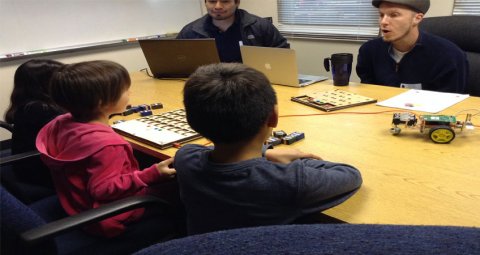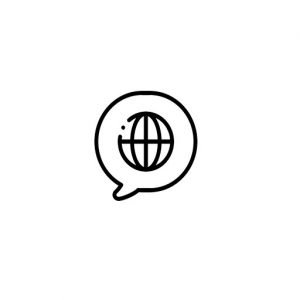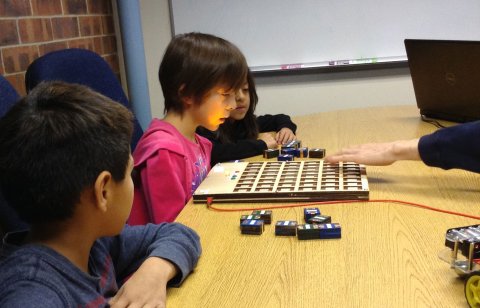Now with Wonders Technology’s teaching tools educators can teach students as young as four how to program complicated technology, such as robots and 3D printers. The Tech Tray works as an input so that students without reading or typing abilities can easily get up and running. By replacing core programming words with building blocks we’ve simplified the process into something that is easy, fun and paves the way for plenty of in depth learning! Learners can place the blocks on the tray in a bunch of different patterns to make a robot roll around in different ways. Wonders Technology has started testing with students at Indian Peaks Elementary and the results are encouraging! With a tiny bit of explanation the first graders were able to use the Tech Tray to make the robot move forward and take a right hand turn in under twenty minutes. The third graders exceeded our expectations and could have gone on to algebra or recursion related concepts after just fifteen minutes of practice with the tray. The students also provided valuable feedback regarding ease of use, what they would like the Tech Tray to look like and ideas for other technologies they might want to control with the tray. Ideas included robotic pets, a crane and other insightful technologies. We gently explained that the school scheduling technology was not on our list, so the busses could not be plugged into the tray. Wonders Technology is thankful to Indian Peaks Elementary for the opportunity to involve their students in our prototyping efforts. Fun was had by all and the students and teachers informed our design process a lot!
What is the Tech Tray?
Wonders Technology’s Tech Tray is a new way for students to create computer code. The Tech Tray is designed to help students create computer code intended to run on a multitude of outputs such as robots, musical synthesizers and 3D printers.
The Tray-
The full sized tray has 48 different slots where students can place building blocks. Students then press one of the output buttons, labeled Robot, Music and 3D Printing, to pass the code to a connected output. The student generated code is translated on a translator unit before the output attempts to run the code and perform the action that the student created. The translator unit will also display the student created code in both block and the pertinent programming language (C/C++, JAVA, Python, Logo, etc) as well as displaying a fun analogous image with the intention of helping the user understand the code as it is being created.
Once students have created code they then press one of the outputs buttons to send the code to a waiting robot, synthesizer or 3D printer.
The Blocks-
The tray works by using many different building blocks, each with a code function or output action labeled on the block. The colors of the blocks corresponds to the type of action the block causes the output to perform. Ie. green blocks make the robot move, yellow blocks help the robot do mathematical procedures. Blocks may be placed in a 2D manner in any of the 48 slots provided on the board. Students may also stack the blocks for certain applications, creating a 3D effect.

The Emerging Methodology-
Younger students just need a positive first experience with tech to form a creative and inquisitive bond with technology for life. The Tech Tray starter blocks do just that by allowing students to get the output to perform a function by placing a single block. Multiple blocks may be placed so the output performs multiple function.
The starter blocks are two colors, which represent the two discrete types of information or procedures that are used to cause the output action. The second set of blocks necessitates two blocks in order to perform the same functions that the students previously created with a single start block. Ie. The starter block for “Move forward 10 cm” is both green and blue to signify that when using the second set of blocks the student needs to find one green block (move forward) and one blue block (the number 10).
By scaffolding the learning process this way our goal is to give easily achieved successes as well as an opportunity for stretch goals.
The instructions for the Tech Tray are written in an easy to understand manner, with illustrations such that even someone without the ability to read can follow them and program a robot.
Beginning goals of the curriculum include simple algebraic concepts, iteration, equalities and inequalities, critical thinking, geometric angles and functions.
The technology is designed to interact with a multitude of outputs and the catalog will grow steadily with time to include different introductory concepts such as languages, physical sciences and finance as well as more advanced concepts for older ages such as chemistry, cryptology and FPGAs.



